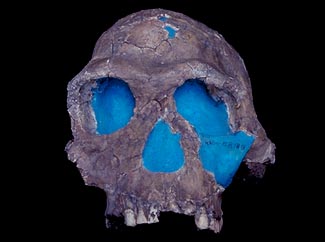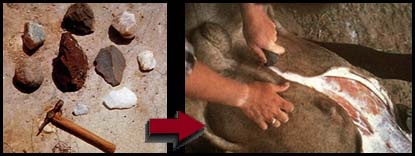
Hominid Species Time Line
Page 21
Homo habilis
H. habilis, "handy or apt or fit man," so-called because of the crude stone tools found with its remains, is one of the earliest Homo species. Habilis existed from approximately 2 million to 1.6 million years ago in east Africa. Males stood a little over 5 feet tall and females were significantly smaller.

KNM ER 1813—Homo habilis
First discovered by the Leakeys, this species has occasioned much controversy. The Leakeys argue that it is ancestral to the subsequent Homo species and modern humans, but others claim it is not, and sill other believe it should be labeled an australopithecine.
The face has little forehead and a sloping profile; its teeth are much larger than those of modern humans but smaller than those of A. africanus. On the other hand, its similarities to earlier australopithecines are striking. Those resemblances and its small brain led many to dispute the assignment of this species to our genus. Some specimens (such as ER 1470) formerly classified as habilis have been re-classified as Homo rudolfensis, and others as Homo ergaster.
The brain size of this species ranges between 500 and 800 cc, overlapping the australopithecines at the low end and H. erectus at the high end. The average brain size, 650 cc, shows a modest advance over the australopithecines. Its skull is slightly more rounded on the top than an australopithecine skull. Interestingly, evidence from one brain cast shows some development of what is called Broca’s area, a bulge on the left hemisphere in modern humans. That is, the brain of this species was beginning to resemble the modern human brain, and the areas related to speech were just starting to emerge.
Habilis has quite long arms, but is efficiently bipedal. Very little is known of its life or mental capabilities, but its remains are often found in conjunction with stone tools. The stone tools shown below are believed to have been fashioned by this species.

These crude hand axes and stone flakes (classified as Oldowan) could have been manufactured as needed or as opportunity arose. The fracture lines of stones create a sharp cutting surface capable of butchering fairly large animals. The photo above right shows a modern anthropologist skinning a calf with a stone tool made just as ancient Homo habilis would have done.
One widely held view of human development has held that the activity of hunting was the, or one of the, chief drivers of evolutionary change in early humans. Hunting, it was argued, would have selected for certain kinds of intelligence, coordination, and aggressive behavior [this is called the "Hunting Hypothesis"]. Was Homo habilis a hunter of large game and a successful competitor with the great predators of Africa—lions, leopards, hyenas? Or was this species an opportunistic taker of small game and a scavenger? Present evidence cannot answer the question, but it seems doubtful. In the meantime, several other explanations, such as an increasing need for “social intelligence,” have been advanced.
 Homo habilis was first discovered in 1959 in the Olduvai Gorge in Tanzania. The nearly complete skull of H. habilis pictured here (inset) was discovered in 1972 at Koobi Fora on the shores of Lake Turkana in Kenya. Its age is estimated at 1.8 million years and its brain capacity at 800 cc. Other H. habilis remains have since been discovered at Olduvai Gorge. Male and female specimens and even one child have been recovered. There is considerable variation among habilis specimens, and they exhibit the usual size differential in males and females.
Homo habilis was first discovered in 1959 in the Olduvai Gorge in Tanzania. The nearly complete skull of H. habilis pictured here (inset) was discovered in 1972 at Koobi Fora on the shores of Lake Turkana in Kenya. Its age is estimated at 1.8 million years and its brain capacity at 800 cc. Other H. habilis remains have since been discovered at Olduvai Gorge. Male and female specimens and even one child have been recovered. There is considerable variation among habilis specimens, and they exhibit the usual size differential in males and females.
References:
http://www.archaeologyinfo.com/homohabilis.htm
Homo habilis on TalkOrigins.org